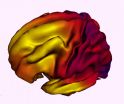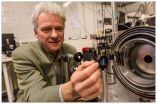(Press-News.org) Turns out, an apple a day won't keep the doctor away but it may mean you will use fewer prescription medications, according to an article published online by JAMA Internal Medicine.
The apple has come to symbolize health and healthy habits. But can apple consumption be associated with reduced health care use because patients who eat them might visit doctors less?
Matthew A. Davis, D.C., M.P.H., Ph.D., of the University of Michigan School of Nursing, Ann Arbor, and coauthors analyzed data from the National Health and Nutrition Examination Survey (2007-2008 and 2009-2010) to find out.
The authors compared daily apple eaters (those who consumed at least 1 small apple per day or 149 grams of raw apple) with non-apple eaters. Of the 8,399 survey participants who completed a dietary recall questionnaire, 753 (9 percent) were apple eaters and 7,646 (91 percent) were non-apple eaters. Apple eaters had higher educational attainment, were more likely to be from a racial or ethnic minority, and were less likely to smoke. The authors measured "keeping the doctor away" as no more than one self-reported visit to a physician during the past year.
There was no statistically significant difference between apple eaters and non-apple eaters when it came to keeping the doctor away when sociodemographic and health-related characteristics were taken into account. However, apple eaters had marginally higher odds of avoiding prescription medications, according to the results. The authors found no difference between apple eaters and non-apple eaters when measuring the likelihood of avoiding an overnight hospital stay or a visit to a mental health professional.
"Our findings suggest that the promotion of apple consumption may have limited benefit in reducing national health care spending. In the age of evidence-based assertions, however, there may be merit to saying 'An apple a day keeps the pharmacist away,'" the study concludes.
Editor's Note: The Prescription is Laughter
In a related Editor's Note, Rita F. Redberg, M.D., of the University of California, San Francisco, and editor-in-chief of JAMA Internal Medicine, writes: "Although we take seriously the statement, 'An apple a day keeps the doctor away' (and the importance of a good parachute), these articles launch our first April Fool's issue. At least once per year, and more is likely better (but needs to be tested), laughter is the best medicine. We look forward to continued editorial chuckles as you send us scientifically rigorous and humorous content that will educate and entertain us all, in time for our next April Fool's issue."
(JAMA Intern Med. Published online March 30, 2015. doi:10.1001/jamainternmed.2014.5466. Available pre-embargo to the media at http://media.jamanetwork.com.)
Editor's Note: This study was supported by an award from the National Institutes of Health. Please see the article for additional information, including other authors, author contributions and affiliations, financial disclosures, funding and support, etc.
INFORMATION:
Media Advisory: To contact corresponding author Matthew A. Davis, D.C. M.P.H., Ph.D., call Laura Bailey at 734-647-1848 or email baileylm@umich.edu. To contact Editor's Note author Rita F. Redberg, M.D., M.Sc. call 312-464-5262 or email mediarelations@jamanetwork.org.
Scientists have developed tiny 'nanoneedles' that have successfully prompted parts of the body to generate new blood vessels, in a trial in mice.
The researchers, from Imperial College London and Houston Methodist Research Institute in the USA, hope their nanoneedle technique could ultimately help damaged organs and nerves to repair themselves and help transplanted organs to thrive.
The nanoneedles work by delivering nucleic acids to a specific area. Nucleic acids are the building blocks of all living organisms and they encode, transmit and express genetic information. ...
Characterizing associations between socioeconomic factors and children's brain development, a team including investigators from nine universities across the country reports correlative links between family income and brain structure. Relationships between the brain and family income were strongest in the lowest end of the economic range - suggesting that interventional policies aimed at these children may have the largest societal impact. The study, led by researchers at The Saban Research Institute of Children's Hospital Los Angeles and Columbia University Medical Center, ...
A new study has confirmed the existence of a positive feedback operating in climate change whereby warming itself may amplify a rise in greenhouse gases resulting in additional warming.
The study, published in the journal Nature Climate Change, shows that in addition to the well understood effect of greenhouse gases on the Earth's temperature, researchers can now confirm directly from ice-core data that the global temperature has a profound effect on atmospheric greenhouse gas concentrations. This means that as the Earth's temperature rises, the positive feedback in the ...
Hamilton, ON (March 30, 2015) - Researchers from McMaster University and the Icahn School of Medicine at Mount Sinai, New York have discovered that a protein associated with neurodegenerative diseases like ALS also plays an important role in the body's natural antiviral response.
The study, published today in Nature Immunology, offers new insight into the link between neurodegenerative disorders and inflammation, and provides a framework to explore more fully the possibility that viral infection may lead to onset of these diseases.
Matthew Miller, an investigator at ...
There are electrical signals in the nervous system, the brain and throughout the human body and there are tiny magnetic fields associated with these signals that could be important for medical science. Researchers from the Niels Bohr Institute have just developed a method that could be used to obtain extremely precise measurements of ultra-small magnetic fields. The results are published in the scientific journal Nature Physics.
The tiny magnetic fields are all the way down on the atomic level. The atoms do not stand still, they revolve around themselves and the axis is ...
Washington, D.C.-- The 2000-2003 drought in the American southwest triggered a widespread die-off of forests around the region. A Carnegie-led team of scientists developed a new modeling tool to explain how and where trembling aspen forests died as a result of this drought. It is based on damage to the individual trees' ability to transport water under water-stressed conditions.
If the same processes and threshold govern the future, their results suggest that more widespread die-offs of aspen forests triggered by climate change are likely by the 2050s. Tree mortality ...
Researchers studying cancer and other invasive diseases rely on high-resolution imaging to see tumors and other activity deep within the body's tissues. Using a new high-speed, high-resolution imaging method, Lihong Wang, PhD, and his team at Washington University in St. Louis were able to see blood flow, blood oxygenation, oxygen metabolism and other functions inside a living mouse brain at faster rates than ever before.
Using photoacoustic microscopy (PAM), a single-wavelength, pulse-width-based technique developed in his lab, Wang, the Gene K. Beare Professor of Biomedical ...
DENVER - Low pre-surgery uptake of a labeled glucose analogue, a marker of metabolic activity, in the primary tumor of patients with stage I non-small cell lung cancer (NSCLC) is associated with increased overall survival and a longer time before tumor recurrence. Patients with high labeled glucose uptake may benefit from additional therapy following surgery.
Surgery is the standard of care for patients with stage I NSCLC but not all patients are cured, as demonstrated by a 5-year survival rate of less than 60% in these patients. There is a clear need for a diagnostic ...
DETROIT - A "perverse disincentive" for hospitals that have invested in expensive technology for robotic surgery may be jeopardizing prostate cancer patients who seek out the procedure, concluded a new study led by Henry Ford Hospital researchers.
The study, which compared complication rates in hospitals with low volumes of robot-assisted radical prostatectomies (RARPs) to institutions with high volumes of the procedure, suggested that current pay-for-performance healthcare models are to blame.
The new study was published online this month by BJU International.
"Patients ...
March 30, 2015 - In women undergoing breast augmentation, a technique using transplantation of a small amount of the patient's own fat cells can produce better cosmetic outcomes, reports a study in the April issue of Plastic and Reconstructive Surgery®, the official medical journal of the American Society of Plastic Surgeons (ASPS).
In particular, the fat grafting technique can achieve a more natural-appearing cleavage--avoiding the "separated breasts" appearance that can occur after breast augmentation, according to the report by Dr. Francisco G. Bravo of Clinica ...





